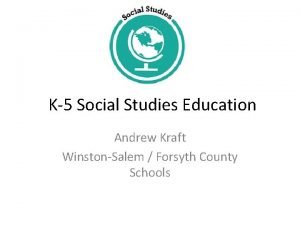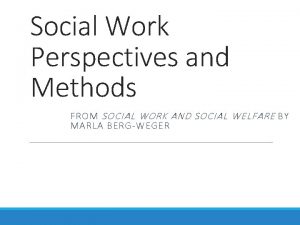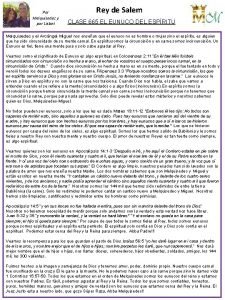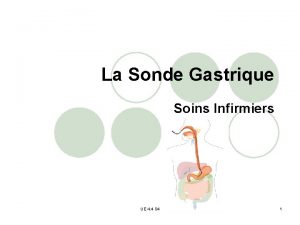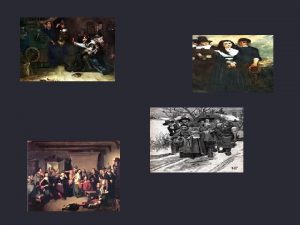Research in Social Work Practice Salem State University










































- Slides: 42

Research in Social Work Practice Salem State University School of Social Work Session Six Jeff Driskell, MSW, Ph. D

Today’s class • Check/Announcements • Lecture▫ Sampling

Follow-up: Article Search

Sampling Design

What Do We Mean by Sampling? • It is NOT going to Costco on a Saturday morning and sampling all the free food. • It is NOT taking a bit out of all the chocolates in the candy box to see which one tastes the best.

Sampling Defined “A process of selecting a group of subjects from a larger population in the hope that studying this smaller group (the sample) will reveal important things about the larger group (the population) from which it is drawn”.

Wedding Cake Scenario

Why is Sampling Important in Research?

Population vs. Sample • Population ▫ A set of people or events in which a sample is drawn. • Sample ▫ Infers population characteristics from a subset of the population Saves money Saves time Can be more accurate – don’t need whole population

What is the sampling frame? Sampling Frame Examples?

Sampling Error • Not representative • Non-response error • Sample error can be reduced: ▫ The larger the sample, the less error ▫ Homogenous samples have less error compared to heterogeneous samples

Sampling Approaches

Sampling Process • • • Definition of target population Selection of a sampling frame (list) Probability or Non-probability sampling Inclusion/exclusion criteria Determine sample size (beyond scope of this class) • Execute the sampling process

Types of Sampling Probability Sampling • • Simple Random Systematic Stratified Cluster Non-Probability Sampling • • Convenience Quota Purposive Snowball

Probability Sampling • Every member of the population has an equal chance of (non-zero) of being selected. RANDOM SELECTION • Allows the researcher to make few observations and generalize to larger population • Selection of elements occurs in a way that portrays the characteristics of the total population.

Random Selection/Sampling Vs Random Assignment

Public Opinion Polls • What sampling frame was identified in this clip? • How is random sampling described? • http: //science 360. gov/obj/video/dc 8 e 0737 -ceac -4582 -bee 9 -5 f 195951 a 01 a/science-behind-newsopinion-polls-random-sampling

Application: • Study aim: To assess grades and social adjustment of students in a U. S. 4 th grade public school suburban classroom • You walk into the classroom to pick a random sample, you choose the first two rows of students. ▫ What is the probability that you have a representative group? ▫ What will this do to your results?

Web Sampling Activity • http: //www. sagepub. com/prsw 2/interactives/e ngines/index. htm

Activity- Applying Research Design and Sampling

Simple Random Sampling • Simplest to implement and understand • By luck of the draw, may not have a good representation of the population • Several random methods

Simple Random Sampling

Systematic Random Sampling • Identical to simple but with a more organized selection system • More precise than simple sampling • Every nth number is selected (i. e. every third or tenth) • Begin with simple random number selection

Systematic Random Sampling

Stratified Random Sampling • Also known as proportional or quota sampling • Divide population into sub-groups then take a simple random sample in each group. • Greater degree of representativeness than simple random sampling • Groups are homogenous

Stratified Random Sampling

Cluster Sampling • Also known as multi-stage • Often used when your population is dispersed over a large geographic area • Drawing a sample in two or more stages ▫ Divide population into clusters ▫ Randomly select clusters ▫ Measure all elements within those clusters

Cluster Example

Non-Probability Sampling • Does not involve random selection • May be able to generalize but does not follow rules of probability theory • More cost effective for agencies to implement • Types ▫ ▫ Convenience Purposive Quota Snowball

Convenience • Once of the most common methods • Obtaining cases based on convenience • Increase in sampling error due to researcher bias

Purposive • Selecting a sample based on one’s knowledge of a population OR based on predetermined characteristics • Often used in qualitative research

Quota • Selecting a stratified non-random sample • Divide population into categories and select a certain number (quota) of subjects from each category

Snowball • Start with one member of a group and use them to assist you in gaining access to other members of the same group • Think of it as a referral system • Often used with hard to reach populations

Case Example- M’LANA • Community based Participatory Research (CBPR)

Limitations to Non-probability • Less representative of your study population compared to using probability sampling • Common uses of non-probability sampling: ▫ Pilot study ▫ Agency based research ▫ Qualitative design

Strengths and Weaknesses of Basic Sampling Techniques Technique Strengths Weaknesses Nonprobability Sampling Convenience sampling Least expensive, least time-consuming, most convenient Low cost, convenient, not time-consuming Sample can be controlled for certain characteristics Can estimate rare characteristics Selection bias, sample not representative, not recommended for descriptive or causal research Does not allow generalization, subjective Selection bias, no assurance of representativeness Time-consuming Easily understood, results projectable Difficult to construct sampling frame, expensive, lower precision, no assurance of representativeness. Can decrease representativeness Judgmental sampling Quota sampling Snowball sampling Probability sampling Simple random sampling (SRS) Systematic sampling Stratified sampling Cluster sampling Can increase representativeness, easier to implement than SRS, sampling frame not necessary Include all important subpopulations, precision Easy to implement, cost effective Difficult to select relevant stratification variables, not feasible to stratify on many variables, expensive Imprecise, difficult to compute and interpret results

Sample Size Common question How large does my sample need to be?

Group Discussion Use the article you selected for class today and answer the following questions: • Who is the study population? • What is the sampling frame? • Probability or Non-probability? • Name the sample strategy (i. e. Snowball) • Strengths/limitations of the design

Determining Your Study Sampling Method and Procedures 1. 2. 3. 4. Define the study population Determine the sampling frame Determine inclusion criteria Determine appropriate sampling method/strategy (random, non-random, snowball) 5. Determine how you will recruit the study population

Qualitative Sampling

Qualitative Sampling • Differs from quantitative sampling methods • Sample can include schools, agencies, or people. • Not concerned with representativeness but more so the depth and quality of the data. • Non-probability approach (not randomized) • Typically a purposive sampling strategy is implemented (eligibility criteria). • Sample size varies (i. e attempt saturation)

Other Sampling Types/Techniques (Patton, 2002) • Extreme or deviant case sampling- “outer edges” of a phenomena • Intensity sampling • Maximum variation sampling • Homogeneous sampling- opposite maximum variation. • Typical case sampling- recruits average members of a population
 Salem state university school of social work
Salem state university school of social work Sjsu social work
Sjsu social work Salem state msw
Salem state msw Salem state career services
Salem state career services Wsfcs social studies
Wsfcs social studies Novosibirsk national research state university
Novosibirsk national research state university Gim in social work
Gim in social work Social casework definition
Social casework definition Theories for direct social work practice
Theories for direct social work practice Siobhan maclean weather model
Siobhan maclean weather model Defining policy practice in social work
Defining policy practice in social work Berg-weger practice of generalist social work download
Berg-weger practice of generalist social work download Wmu school of social work
Wmu school of social work Boston university social work
Boston university social work Social work boundaries quiz
Social work boundaries quiz University of texas arlington msw
University of texas arlington msw Boston university school of social work
Boston university school of social work University of memphis school of social work
University of memphis school of social work Griffith university social work
Griffith university social work Social group model
Social group model Social welfare vs social work
Social welfare vs social work Principle of dramatization
Principle of dramatization Relation of social work with other social sciences
Relation of social work with other social sciences Global agenda for social work and social development
Global agenda for social work and social development Social work: an empowering profession 9th edition chapter 1
Social work: an empowering profession 9th edition chapter 1 Social thinking adalah
Social thinking adalah Social thinking social influence social relations
Social thinking social influence social relations Salem witch trials discovery education
Salem witch trials discovery education What sort of evidence was used to arrest accused witches
What sort of evidence was used to arrest accused witches Contributors
Contributors National geographic salem witch trials
National geographic salem witch trials Melquisedec lisbet
Melquisedec lisbet Plateau
Plateau Nicole salem
Nicole salem Describe the types of homes that probably existed in salem
Describe the types of homes that probably existed in salem Her presence has a calming effect on betty
Her presence has a calming effect on betty Gastric decompression vs lavage
Gastric decompression vs lavage Dbq salem witch trials
Dbq salem witch trials What duty was mary warren performing in the court
What duty was mary warren performing in the court Salem sump sonda
Salem sump sonda Sonde de salem
Sonde de salem Types of enema
Types of enema What caused the salem witch trial hysteria
What caused the salem witch trial hysteria




